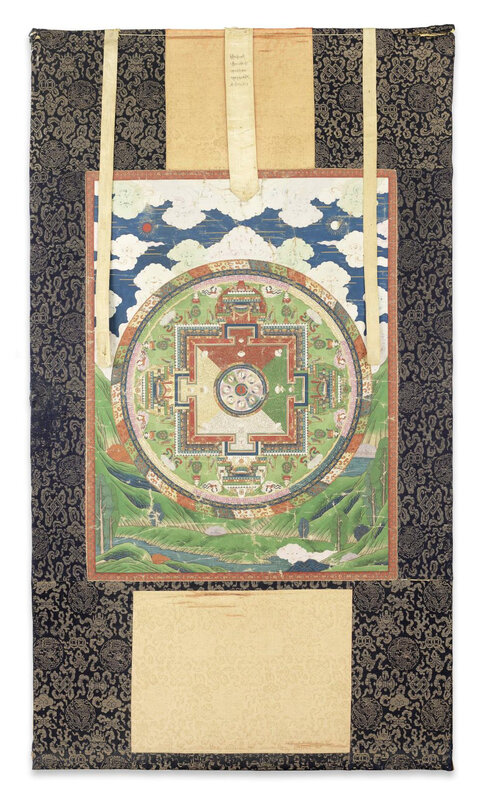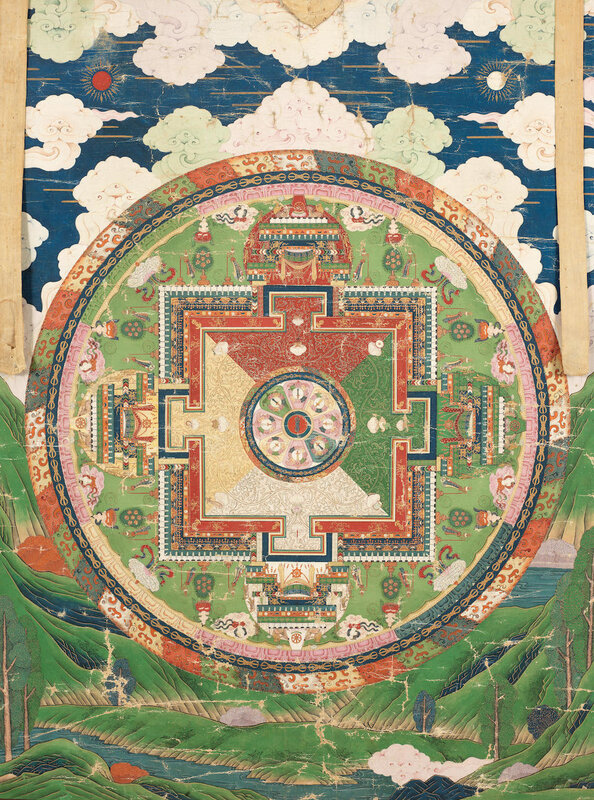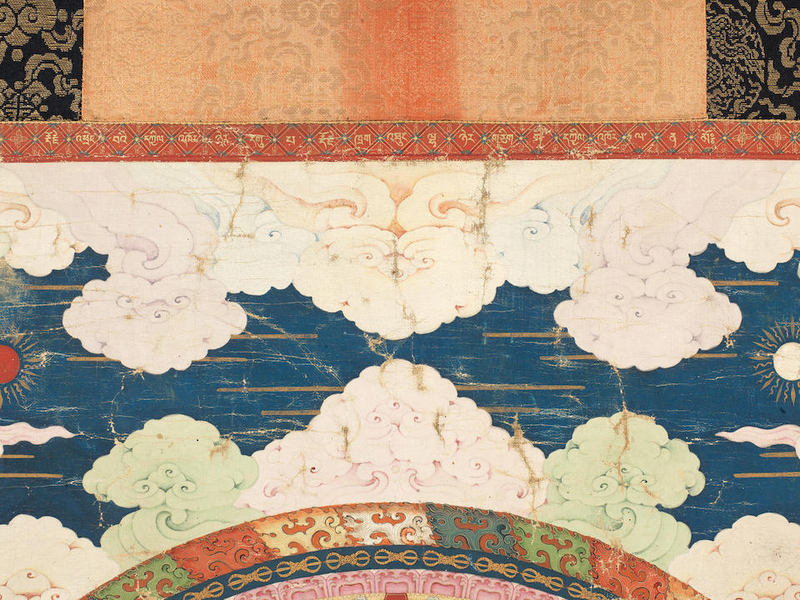An imperial painting of a Vajraheruka 'twenty-one' deity mandala Tibeto-Chinese, Qianlong Period, circa 1750-1763
Lot 192. An imperial painting of a Vajraheruka 'twenty-one' deity mandala Tibeto-Chinese, Qianlong Period, circa 1750-1763Distemper on cloth, inscribed on upper and lower border, with original silk mounts, 74cm (29 1/8in) high x 55.5cm (21 7/8in) wide; with silk mounts: 134cm (52 6/8in) high x 75cm (29 1/2in) wide. Estimate £ 20,000-30,000. Sold for £ 62,562 (€ 69,695). Courtesy Bonhams.
Note: The vibrant composition is decorated with auspicious figures arranged around a lotus blossom within the walls of a palace, all above a large lotus with flaming border with flying garland-bearers, all set within a mountainous landscape interspersed with flowing streams and vaporous ruyi clouds, silk mount.
Inscribed on the silk ribbon: ཉེར་དགུ་
'Twenty-one'
Inscribed along the top edge and on top of silk ribbon: རྡོ་རྗེ་འཕྲེང་བའི་དཀྱིལ་འཁོར་ཉེར་དགུ་པ་རྡོ་རྗེ་ཁྲག་འཐུང་ལྷ་ཉེར་གཅིག་གི་དཀྱིལ་འཁོར།།
'Twenty-one deity mandala of Dorjé Trantung (Vajraheruka), the 29th mandala of the Vajrāvalī'.
Inscribed along the lower edge: ལྕང་སྐྱ་སྤྲུལ་སྐུ་རིན་པོ་ཆེས་ཐིག་སོགས་ཀྱི་བཀོད་པ་གནང་ནས་རྒྱལ་སྲས་བཅུ་གཉིས་པ་ཡུན་ཐོའུ་གྱི་ལྷག་བསཾས་དག་པས་ཕུལ་པའི་རྡོར་ཕྲེངགི་དཀྱིལ་འཁོར་ ཉེར་དགུ་པ་རྡོ་རྗེ་ཁྲག་འཐུང་ལྷ་ཉེར་གཅིག་གི་དཀྱིལ་འཁོར།།
'Twenty-one deity mandala of Dorjé Trantung (Vajraheruka), the 29th mandala of the Vajrāvalī offered by the twelfth prince Yuntou gyi Lhaksem Dakpa (Yintao) after a design bestowed by the Changkya Trülku Rinpoché.
This remarkable painting would have been part of a larger set of probably forty-four paintings depicting the mandalas of the Vajravali compendium. In place of the deities are depictions of the main attributes of Vajraheruka, the deity to when this work was dedicated. Compositions such as the present example are known as 'symbol mandalas' and are equal in meaning and function to mandala paintings that depict all of the figures described in the elaborate Tantric ritual.
According to the inscription located at the bottom of the painting, the present mandala was commissioned by the twelfth prince Yintao.
According to contemporary records, Yintao spent his adolescence between Beijing and the various retreats and palaces around the capital. In the later phase of his life, he presided over various ceremonial and bureaucratic offices. When the issue arose of who would be the successor of his father and infighting took place within the Imperial household, Yintao and several of his brothers were demoted when Prince Yinzhen rose to become the Yongzheng emperor (r. 1722-1735). Following Yongzheng's death, Yintao regained some of his previous titles under the rule of his nephew, the Qianlong emperor (r. 1735-1796). See P.Berger, Empire of Emptiness: Buddhist Art and Political Authority in Qing China, Honolulu, 2003, pp.186-187.
Changkya Rolpa'i Dorje (1717-1786) was raised in the Qing court and became the most important Buddhist figure in Beijing. At a young age, he was recognized as the next incarnation of the Changkya lineage, which was based at the Gönlung Jampa Ling, a Gelugpa monastery in Amdo. The monastery was eventually destroyed by the Qing forces when some of its residents rose up in rebellion against the Chinese court in 1724. Changkya was however invited back to Beijing, where he was raised within the court and instructed in Buddhist studies alongside Yongzheng's son, Prince Hungli, who later became the Qianlong emperor.
In 1734, when Rolpa'i Dorje returned to Tibet to accompany the 7th Dalai Lama from his visit to Beijing, he travelled to Shigatse, where he studied under the Panchen Lama and was ordained as a full monk. Following the death of the Yongzheng emperor in 1736, he returned to Beijing where he was put in charge of the Buddhist affairs in the capital. There he served as religious preceptor to the Qianlong emperor. Throughout his career, Rolpa'i Dorje exerted great influence on the relations between the Qing court and the Buddhist institutions in Tibet. He advised Qianlong to recognise the Dalai Lama as the spiritual and secular leader of Tibet. This means led to the promotion of the Gelug sect over other Tibetan Buddhist schools. Rolpa'i Dorje had an active role in recognizing the next incarnation of the Dalai Lama in 1757, following the death of the seventh leader. He also encouraged the Panchen Lama to visit Beijing for an official audience with Qianlong in 1779. For the occasion, a set of paintings depicting the previous incarnations of the Panchen Lama were commissioned.
The presence of Rolpa'i Dorje in Beijing led to a great development of Tibetan Buddhism within the capital. In 1741, the religious leader began to translate the Sutra on Iconometry (in Chinese, called Zaoxiang liangdu), together with Gonpokyab, a Mongolian monk. Laying out the methods for designing Buddhist images, the text became the standard for religious artists working in the Imperial court.
A very similar 18th century mandala, inscribed with very similar inscriptions as the present lot and believed to originate from the same set as the present example, was sold at Christie's New York, 16 September 2014, lot 288.
Bonhams. Fine Chinese Art, London, 5 Nov 2020.

/https%3A%2F%2Fprofilepics.canalblog.com%2Fprofilepics%2F1%2F0%2F100183.jpg)
/https%3A%2F%2Fstorage.canalblog.com%2F03%2F02%2F119589%2F96711876_o.jpg)
/https%3A%2F%2Fstorage.canalblog.com%2F11%2F31%2F119589%2F94773502_o.jpg)
/https%3A%2F%2Fstorage.canalblog.com%2F20%2F83%2F119589%2F94772815_o.jpg)
/https%3A%2F%2Fstorage.canalblog.com%2F26%2F72%2F119589%2F75604929_o.jpg)
/https%3A%2F%2Fstorage.canalblog.com%2F59%2F60%2F119589%2F26458628_o.jpg)












/image%2F1371349%2F20240426%2Fob_dcd32f_telechargement-32.jpg)
/image%2F1371349%2F20240426%2Fob_0d4ec9_telechargement-27.jpg)
/image%2F1371349%2F20240426%2Fob_fa9acd_telechargement-23.jpg)
/image%2F1371349%2F20240426%2Fob_9bd94f_440340918-1658263111610368-58180761217.jpg)